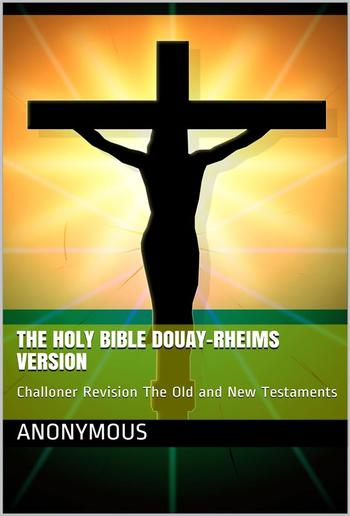
Anonymous - The Bible, Douay-Rheims, Complete
The Bible, Douay-Rheims, Complete
Anonymous
Description
Challoner's revised Douay-Rheims Version (Old Testament 1609 & 1610, New Testament 1582). The Whole Revised and Diligently Compared with the Latin Vulgate by Bishop Richard Challoner A.D. 1749-1752
With Annotations
Contents
The Old Testament (Vol I-II Books)
The New Testament (Vol III Books)
Appendices:
The Prayer of Manasses
The Third Booke of Esdras
The Fourth Booke of Esdras
The Prophecie of Abdias
The Catholike Epistle of Iude the Apostle
The Preface to the Reader (selection from 1582)
Hard Wordes Explicated.
The Douay–Rheims Bible (also known as the Rheims–Douai Bible or Douai Bible, and abbreviated as D–R and DRB) is a translation of the Bible from the Latin Vulgate into English made by members of the English College, Douai, in the service of the Catholic Church. The New Testament portion was published in Reims, France, in 1582, in one volume with extensive commentary and notes. The Old Testament portion was published in two volumes twenty-seven years later in 1609 and 1610 by the University of Douai. The first volume, covering Genesis through Job, was published in 1609; the second, covering Psalms to 2 Machabees plus the apocrypha of the Vulgate was published in 1610. Marginal notes took up the bulk of the volumes and had a strong polemical and patristic character. They offered insights on issues of translation, and on the Hebrew and Greek source texts of the Vulgate.
The purpose of the version, both the text and notes, was to uphold Catholic tradition in the face of the Protestant Reformation which up till then had dominated Elizabethan religion and academic debate. As such it was an impressive effort by English Catholics to support the Counter-Reformation. The New Testament was reprinted in 1600, 1621 and 1633. The Old Testament volumes were reprinted in 1635 but neither thereafter for another hundred years. In 1589, William Fulke collated the complete Rheims text and notes in parallel columns with those of the Bishops' Bible. This work sold widely in England, being re-issued in three further editions to 1633. It was predominantly through Fulke's editions that the Rheims New Testament came to exercise a significant influence on the development of 17th century English.
Much of the text of the 1582/1610 bible employed a densely Latinate vocabulary, making it extremely difficult to read the text in places. Consequently, this translation was replaced by a revision undertaken by bishop Richard Challoner; the New Testament in three editions of 1749, 1750, and 1752; the Old Testament (minus the Vulgate apocrypha), in 1750. Although retaining the title Douay–Rheims Bible, the Challoner revision was a new version, tending to take as its base text the King James Version rigorously checked and extensively adjusted for improved readability and consistency with the Clementine edition of the Vulgate. Subsequent editions of the Challoner revision, of which there have been very many, reproduce his Old Testament of 1750 with very few changes. Challoner's New Testament was, however, extensively revised by Bernard MacMahon in a series of Dublin editions from 1783 to 1810. These Dublin versions are the source of some Challoner bibles printed in the United States in the 19th century. Subsequent editions of the Challoner Bible printed in England most often follow Challoner's earlier New Testament texts of 1749 and 1750, as do most 20th-century printings and on-line versions of the Douay–Rheims bible circulating

